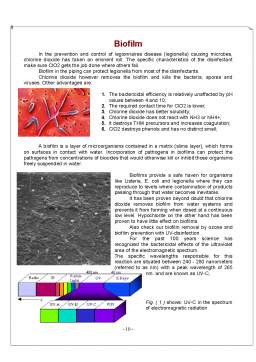Cuprins
- Introduction 1
- Waste Water Treatment 1
- Physical / Chemical Treatment 1
- Biological Treatment 1
- Process water production 3
- Water filtration for industrial wastewater and water recyling
- processes 3
- Softening 5
- Active carbon adsorption 5
- Ion Exchanger 7
- Water filtration - Ozone disinfection - Sand filters 8
- Disinfection 12
- Iron Removal 14
- Water Recycling 14
- Bibliography 16
Extras din proiect
The Chemical Treatmeant of
Redizual Waters
Introduction
Without exception, the present world depends on chemical products to increase the production of foodstuffs, protect health and facilitate our daily lives. Also, the number of these substances that must be extracted and concentrated from natural materials or synthetic laboratory processes is increasing every day.
Many of these chemical products are hazardous and the direct or indirect health risks in their use, storage or disposal must be evaluated. Intentional or not, their discharge to the environment can cause serious consequences.
When large quantities of these chemicals that did not exist in nature are generated or utilized, significant problems can result, especially when known physical or biological processes cannot be depended upon to degrade them to innocuous forms.
The pollution is everywhere: in the air, in the water, which includes all the living organisms and on the land, where especially in big cities.
We’ll only discuss about the water pollution and the methods of desinfecting it for the future use.
Waste Water Treatment
Industrial waste water treatment using various technologies:
Equalization tanks
Wastewater applications
Reduction of: Chemical Oxygen Demand (COD) / Biological Oxygen Demand (BOD)
Grease and oil removal
Minerals removal
Pesticides removal
Decolourisation
Sludge dewatering
Nitrification and denitrification.
Physical / Chemical Treatment
Physical chemical waste water treatment techniques are techniques to remove the coarse fraction. Oil, fatty acids and suspended solids could be removed by the use of the following techniques:
Biological Treatment
Biological treatment of waste water is used to lower the organic load of soluted organic compounds. There are two main catagories:
Aerobic treatment
Anaerobic treatment
The organic load is defined by the Biological Oxygen Demand (BOD).
In aerobic systems the water is aerated with compressed air (in some cases oxygen). Anaerobic systems run under oxygen free conditions.
Biological Water Treatment Plant
Drum filter
The Hydrotech Drum filter is a mechanical and self cleaning filter specially designed with a view to achieving high performance in systems where it is essential to prevent the particles from fragmentation. The filter works without pressure and is robustly designed with few moving parts to ensure long life and low maintenance costs.
The liquid is filtered through the periphery of the slowly rotating drum. Assisted by the filter elements' special structure, the particles are carefully separated from the liquid. Separated solids are rinsed off the filter cloth into the solids collection tray and discharged.
For larger flows disc filtration can be more appropriate. Drum filters are ideal for water recycling and as polishing in combination with other waste water treatment systems
Advanced Oxidation
Advanced chemical oxidation processes make use of (chemical) oxidants to reduce COD/BOD levels, and to remove both organic and oxidisable inorganic components. The processes can completely oxidise organic materials to carbon dioxide and water, although it is often not necessary to operate the processes to this level of treatment
A wide variety of advanced oxidation processes are available:
chemical oxidation processes using hydrogen peroxide, ozone, combined ozone & peroxide, hypochlorite, Fenton's reagent etc.
ultra-violet enhanced oxidation such as UV/ozone, UV/hydrogen peroxide, UV/air
wet air oxidation and catalytic wet air oxidation (where air is used as the oxidant)
Advanced oxidation processes are particularly appropriate for effluents containing refractory, toxic or non-biodegradable materials. The processes offer several advantages over biological or physical processes, including:
process operability
unattended operation
the absence of secondary wastes
the ability to handle fluctuating flow rates and compositions
However, advanced oxidation processes often have higher capital and operating costs compared with biological treatment.
The most suitable variant for each application is chosen on the basis of the chemical properties of the effluent.
Preview document
Conținut arhivă zip
- The Chemical Treatmeant of Rezidual Water.doc

















